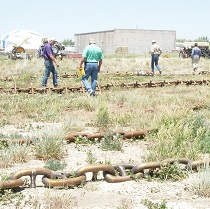Description
Anchor chains are designed for use on large ships and off-shore drilling rigs. Used anchor chain is sometimes used for seedbed preparation in revegetation. Their use in tree felling is covered in the Anchor Chains and Modified Chains sections of the Mechanical Control chapter. Chains are sized by the diameter of the round stock. Revegetation projects normally use chain sizes between 2 and 3 inches. Within this range, individual links are 12 to 18 inches in length and weigh between 25 and 86 pounds. The resulting weight per foot of chain is about 37 to 88 pounds, respectively. Anchor chain is usually sold in 90-foot lengths called “shots.” Further specifications on weight and link size are listed in the Appendix.
Application
Anchor chains are pulled in a “U” shape between two crawler tractors. The distance between the two tractors depends on the force required to pull the chain. An initial distance of 1/3rd the length of the chain is a rule-of-thumb. Size and length of the chain are factors as well as the size of the tractors. The tractors can be further apart when preparing a seedbed than when felling trees. Chain length is usually between 200 to 400 feet. Length can be adjusted easily with standard cutting and welding tools. Crawler tractors used for chaining vary from 140 to 350 horsepower. Production rates vary from 20 to 70 acres/hour. Chaining has been used effectively on debris-littered land to prepare seedbeds for broadcast seeding. Soil disturbance is usually in the top 1 to 2 inches of soil. Chaining a second time in the opposite direction is useful if soil disturbance for seeding is insufficient after the first pass. Chaining has also been used to cover the seed following broadcast seeding. Chain size and soil type and condition must be considered to achieve desired results. Dry, clay soil may require multiple passes with a heavy chain while one pass may be sufficient in sandy loam soil. Chains have a tendency to become buried in very sandy soils with dunes.
Used anchor chain can be purchased from marine supply or salvage companies located in coastal cities of the United States.
References / Additional Information
Wiedemann, H.T. 2007. Sculpting brush mechanically: Current state of the art. Rangelands. 29(5): 10-17.


